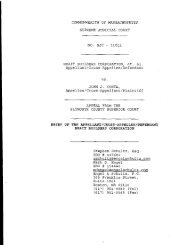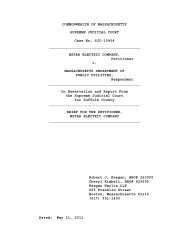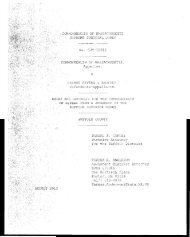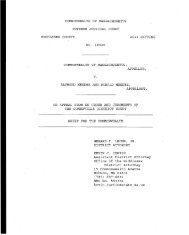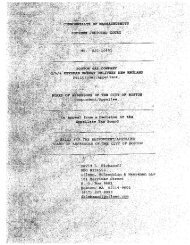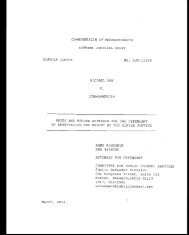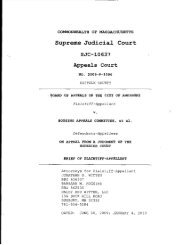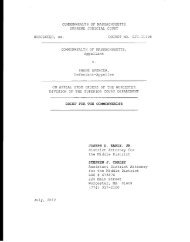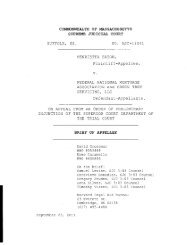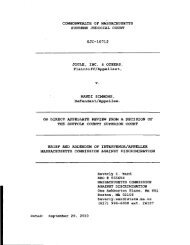465 Mass. 102 - Appellant Medina Brief - Mass Cases
465 Mass. 102 - Appellant Medina Brief - Mass Cases
465 Mass. 102 - Appellant Medina Brief - Mass Cases
Create successful ePaper yourself
Turn your PDF publications into a flip-book with our unique Google optimized e-Paper software.
•<br />
• TABLE OF CONTENTS<br />
TABLE OF AUTHORIT ................................ J.J.<br />
ISSUES PRESENTED ..................................... 1<br />
• STATEMENT OF THE CASE ................................ 1<br />
•<br />
•<br />
•<br />
PRIOR PROCEEDINGS AND STATEMENT OF FACTS ............. 3<br />
STANDARD OF REVIEW ................................... 7<br />
ARGUMENT ....... . . . . . . . . . . . . . . . . . . . . . . . . . . . . . . . . . . . . . . 8<br />
I. DR. HOCHBERG'S DUTY TO WARN HIS PATIENT AGAINST<br />
DRIVING WHILE SUBJECT TO SEIZURES EXTENDS TO THE<br />
DRIVING PUBLIC ....................................... 8<br />
A. The Physician's Duty ses From: (i) s Creation<br />
Of A sk And (iil The Physician-Patient ationship<br />
.. . .. .. . .. .. .. .. .. .. .. .. .. .. .. .. . .. .. ".. " .. .. .. .. .. .. .. ., .. .. .. .. .. .. .. .. .. .. .. .. ., .. .. .. .. .. .. .. .. a<br />
i.. Risk Creation""""." ............ " ... " . It " " " " " ......... ., .. " .... " B<br />
ii. The , Physician-Patient Relationship<br />
........... 11<br />
B. Dr. Hochberg's Duty To Warn Extends The Driving<br />
Public Under Ordi Principles Negligence ..... 15<br />
II. THE RECOGNITION OF A SPECIAL RELATIONSHIP WITH<br />
POTENTIAL THIRD-PARTY VICTIMS IS CONSISTENT WITH<br />
MASSACHUSETTS COMMON LAW AND STATUTORY LAW .......... 17<br />
III. PUBLIC ICY SUPPORTS THE IMPOSITION A DUTY<br />
TO WARN A PATIENT AGAINST DRIVING WHILE SUBJECT TO<br />
ZURES " .. It .. " " ...... '" .. " .. " " " " .... " ............ "" .. " " " " " .. " .............. " " 23<br />
IV. SUMMARY JUDGMENT WAS INAPPROPRIATE BECAUSE THERE<br />
ARE DISPUTED ISSUES OF MATERIAL FACT ................ 28<br />
CONCLUSION .......................................... 32<br />
CERTIFICATION ....................................... 33
•<br />
•<br />
•<br />
•<br />
•<br />
TABLE OF AUTHORITIES<br />
CASES<br />
Adamian v. , Inc.<br />
353 Ma s s. 4 98 (1968) .............................. 18<br />
Allstate Insurance Company v. Dalyrymple<br />
883 F.Supp. 963 (1995) ............................ 30<br />
Brune v. Bel ff<br />
354 <strong>Mass</strong>. <strong>102</strong> (1968) .......................... 11, 12<br />
Carey v. New England Organ Bank<br />
446 <strong>Mass</strong>. 270 (2006) ............................... 7<br />
Carr v. Howard<br />
5 <strong>Mass</strong>. L. Rep. 63 (Norfolk Super. .1996) ... 19, 21<br />
Cassesso v. Comm'r of Carr.<br />
390 <strong>Mass</strong>. 419, 422 (1983) ......................... 29<br />
Coombes v. Florio<br />
450 <strong>Mass</strong>. 182 (2007) .......................... pass.un<br />
• Duvall v. Goldin<br />
139 Mich. App. 342 (1985) ................. 26, 27, 29<br />
•<br />
•<br />
•<br />
Freese v. Lemmon<br />
210 N.W.2d 576 (Iowa 1973) ........................ 31<br />
v. Tips<br />
651 S.W. 2d 364 (Tex. App. Ct. 1983) .......... 24, 28<br />
v. Allstate Ins. Co.<br />
883 F.Supp.963 (0.Oel.1995) ................... 27, 31<br />
Hub Associates, Inc. v.<br />
357 Ma s s. 4 4 9 (1970) ............................... 7<br />
Irwin v. Town of Ware<br />
3 92 Ma s s. 74 5 (1984) .............................. 20<br />
Joy v. Eastern Maine Med. Ctr.<br />
529 A.2d 1364 (Me.19B7) ........................... 27<br />
• Lev v. Beverly Enterprises-<strong>Mass</strong>achusetts, Inc.<br />
4 57 Ma s s. 23 4 ( 2 0 10) ............................... 7<br />
•<br />
ii
•<br />
•<br />
•<br />
Luoni v. Thomas Berube<br />
431 Ma s s. 72 9 ( 2 000) .............................. 18<br />
Maffei v. Roman Catholic shop of Boston<br />
4 4 9 Ma s s. 2 3 5 ( 2 007) ............................... 7<br />
McGuiggan v. New England Tel. & Tel. Co.<br />
398 Ma s s. 152 (1986) .............................. 18<br />
McKenzie v. Hawai'i Permanente Med. Group, Inc.<br />
98 Haw. 296 (2002) ................................ 27<br />
• <strong>Medina</strong> v. llemer<br />
2005 WL 3 7226 (Suffolk . Ct. 2005) .... . passim<br />
•<br />
•<br />
•<br />
•<br />
•<br />
Mullins v. Manor ColI , 389 <strong>Mass</strong>. 47 (1983)<br />
389 <strong>Mass</strong>. 47 (1983) ............................... 18<br />
Myers v. Queensberry<br />
144 Cal. App. 3d 888 (1983) ................... 26, 30<br />
Pederson v. Time, Inc.<br />
404 s. 14, 16-17 (1989) ....................... 7, 29<br />
Poskus v. Lombardo's of Randolph<br />
4 2 3 Ma s s. 637 (1996 ) .............................. 19<br />
Riggs v. stie<br />
342 <strong>Mass</strong>. 402 (1961) .............................. 12<br />
Small v. Howard<br />
128 <strong>Mass</strong>. 131 (1880) .............................. 12<br />
Schuster v. Altenberg<br />
144 Wis.2d 223 (1988) ............................. 28<br />
Stepakoff v. Kantar<br />
393 <strong>Mass</strong>. 836 (1985) .............................. 11<br />
Taylor v. Smith<br />
892 So.2d 887, 893-94 (Alabama Sup.Ct. 1994) ...... 27<br />
Welke v. Kuzilla<br />
144 Mich.App. 245 (1985) .......................... 26<br />
• Wharton Transport Corp. v. Bridges<br />
606 SW2d 521 (1980, Tenn) ......................... 16<br />
iii
•<br />
•<br />
•<br />
•<br />
•<br />
•<br />
•<br />
•<br />
•<br />
•<br />
•<br />
Wilschinsky v. <strong>Medina</strong><br />
108 N.M. 511, 515 (1989) .......................... 27<br />
Zavalas v. State Dep't of Carr.<br />
124 Ore.App. 166 (1993) ........................... 28<br />
STATUTES<br />
5 4 0 CMR § 2 4 • 0 5 • • • • • • • . . • • • • • • • . • • • • . . • . • • • • . • • • • . • • 2 5<br />
M.G.L.A. 112 § 129A ............................. 21, 22<br />
SECONDARY SOURCES<br />
51 MAPRAC § 2. 2 .................................... 12<br />
Prosser, William L.<br />
Handbook of The Law of Torts (4th ed. 1971) ....... 14<br />
iv
ISSUES PRESENTED<br />
i. Does a physician have a special relationship,<br />
either with s patient or with the eseeable<br />
class of victims, that imposes a duty upon the<br />
physician to advise a patient who is subject to<br />
seizures not to drive a motor vehicle?<br />
ii. Alternatively, a physician's indication to<br />
his s zure-prone patient that driving is<br />
permitt cons tute a creation of risk?<br />
iii. Does the sk of rm created by this a rmat<br />
act extend to third-party ctims under the<br />
Coombes lding?<br />
iv. Is there a dispute of material s, such that<br />
summary judgment for Dr. Hochberg was improper?<br />
STATEMENT OF THE CASE<br />
This civil action was init lly entered in the<br />
Superior Court Department of the T al Court for<br />
Suffolk County. The action was commenced by<br />
aintiff-<strong>Appellant</strong>, Richard <strong>Medina</strong> ("<strong>Medina</strong>"),<br />
against Francine Pillemer, As Executrix of The Estate<br />
of Robert D. Riskind ("Riskind") on January 23, 2004.<br />
Riskind was suffering from a non-curable<br />
malignant in tumor which made him subject to<br />
zures. He was treating for this condition with a<br />
1
neurologist, H. Hochberg, M.D. (Dr. Hochberg).<br />
Dr. Hochberg was aware that Riskind was regularly<br />
driving a motor vehicle and iled to warn, advise, or<br />
instruct Riskind not to drive, despite the fact that<br />
Riskind was experiencing severe neurological symptoms.<br />
Instead, he affirmatively indicated to Riskind in<br />
writing that driving was permitted.<br />
On December 10, 2001, Riskind had a zure while<br />
driving a motor vehicle, which caus him to serious<br />
ure t Plaintiff-<strong>Appellant</strong>, <strong>Medina</strong>. On April 25,<br />
2005, the Superior Court (Gants, J.) allowed <strong>Medina</strong>'s<br />
motion to add Dr. Hochberg as a party defendant, on<br />
the grounds that breached his duty to the driving<br />
public.<br />
However, on July 25, 2011, the Superior Court<br />
(Hogan, J.) issued a decision allowing summary<br />
judgment for Dr. Hochberg, contradicting 2005<br />
Decision. The court concluded that this commonwealth<br />
does not recognize a physician's duty to a third party<br />
to warn his patient against driving while subject to<br />
seizures.<br />
2
•<br />
6. September 19, 2001, Dr. Hochberg's notes<br />
• indi Riskind continued to have two to three<br />
seizures a y. See App: A-43.<br />
7. On 17, 2001, Dr. Hochberg wrote a letter<br />
• to Riskind, stating: "You are now able to ... drive<br />
a car".<br />
• 8 . On December 10, 2001, Riskind was driving a car<br />
on Washington reet Newton, <strong>Mass</strong>achusetts, when he<br />
suffered a seizure, by his neurological<br />
• condition. As a re having a seizure while<br />
driving, the automobi<br />
by Riskind veered<br />
from the highway, st<br />
Plaintiff-<strong>Appellant</strong><br />
• <strong>Medina</strong>, a pedestrian who was walking to the trunk of<br />
•<br />
•<br />
•<br />
his car. <strong>Medina</strong> suf<br />
of the motor vehicle<br />
334, A-33S.<br />
severe injuries as a result<br />
9. On January 23, 2004, <strong>Medina</strong> 1 s t k<br />
Superior Court against Francine Pillemer, As Executrix<br />
of The Estate of Riskind. The Complaint all<br />
said decedent, Riskind, was negligent operat s<br />
motor vehicle on December 10, 2001, which resulted<br />
said vehicle to swerve off the highway and strike and<br />
• ure the plaintiff, <strong>Medina</strong>, a pedestrian who was<br />
•<br />
wal to the trunk of his car. A certified copy of<br />
4<br />
A
•<br />
the Superior docket entries and a copy of<br />
• Complaint are at hereto. See App: A-1, A-9.<br />
10. On January 8, 2005, the plaintiff obtained<br />
complete cal from Dr. Hochberg. The<br />
• plainti promptly had the medical records<br />
reviewed by a expert, John M. Friedberg,<br />
• M.D. ("Dr. ), to determine whether there was<br />
any the standard of care by Dr.<br />
Hochberg to advise, warn or instruct<br />
• Riskind not to e a motor vehicle. Dr.<br />
•<br />
•<br />
•<br />
•<br />
established "the seizure of December 10, 2001,<br />
was reas seeable u and concluded as follows:<br />
"Dr. rg, a professor of neurology who<br />
knows and knew his patient Dr.<br />
Riskind, have expressly and repeatedly<br />
, instructed, and warned his<br />
no uncertain terms never to operate a<br />
Dr. Hochberg's failure to do so,<br />
cit encouragement to his patient<br />
to continue , is incomprehensible and a<br />
signi rture from the standard of<br />
medical part of a neurologist. It<br />
clearly ow the standard of care of the<br />
ave neurologist and was a major<br />
contribut in the accident of December<br />
10, 2001, severely injured your client,<br />
Richard <strong>Medina</strong>./l See App: A-54.<br />
11. On March 16, 2005, <strong>Medina</strong> filed a motion with the<br />
Superior Court to Dr. Hochberg as a party<br />
• defendant and to Ie his First Amended Complaint. See<br />
App: A-13.<br />
•<br />
5
•<br />
•<br />
12. On April 25, 2005, the Superior Court (J. Gants)<br />
issued a decision (hereinafter "the 2005 Gants<br />
decision"), allowing the Plaintiff's motion to add Dr.<br />
Hochberg as a party defendant on the grounds that Dr.<br />
• Hochberg had a duty to advise his patient against<br />
driving while subject to seizures. See App: A-57.<br />
• 13. On July 25, 2011, the Superior Court (J. Hogan)<br />
contradicted the 2005 Gants decision and allowed<br />
•<br />
•<br />
•<br />
summary judgment for Dr. Hochberg. The court ruled<br />
that a physician does not owe a duty to the driving<br />
public to warn his patient against driving as a iesult<br />
of a seizure disorder. Judgment was entered on August<br />
5, 2011. See App: A-336, 383, 402.<br />
14. On August 31, 2011, <strong>Medina</strong> filed a notice of<br />
appeal. See App: A-6. On February 8, 2012, the case<br />
was docketed in the Appeals Court. SeeApp: A-404.<br />
15. On February 15, 2012, <strong>Medina</strong> filed an Application<br />
• for Direct Appellate Review with the Supreme Judicial<br />
•<br />
Court. On March 27, 2012, the Court allowed <strong>Medina</strong>'s<br />
application.<br />
16. On April 6, 2012, this case was entered on the<br />
docket of the Supreme Judicial Court. On April 11,<br />
2012, the Court allowed <strong>Medina</strong>'s Motion to file this<br />
amended brief.<br />
6
STANDARD OF REVIEW<br />
The standard of review of a grant of summary<br />
judgment is whether, viewing the evidence in the light<br />
most favorable to the nonmoving party, all material<br />
facts have been established and the moving party is<br />
entitled to judgment as a matter of law. Lev v.<br />
Beverly Enterprises-<strong>Mass</strong>achusetts, Inc., 457 <strong>Mass</strong>.<br />
234, 237 (2010). In order to be entitled to summary<br />
judgment, the moving party must affirmatively show<br />
that there is no real issue of fact. Hub Associates,<br />
Inc . .'Y..:.. Goode, 357 <strong>Mass</strong>. 449, 258 N.E.2d 733, (1970).<br />
See Iso Pederson .'Y..:.. Time, Inc., 404 <strong>Mass</strong>. 14, 16-17<br />
(1989) (the moving party has the burden of<br />
establishing that no material facts are in dispute) .<br />
On review of a motion judge's order granting<br />
summary judgment, the Appellate Court reviews the<br />
motion judge's legal conclusions de novo. Maffei .'Y..:..<br />
Roman Catholic Archbishop of Boston, 449 <strong>Mass</strong>. 235<br />
(2007). When the Supreme Judicial Court reviews a<br />
summary judgment motion, it makes all permissible<br />
inferences favorable to the nonmoving party and<br />
resolves any disputes or conflicts in summary judgment<br />
materials in their favor. Carey .'Y..:.. New England Organ<br />
Bank, 446 <strong>Mass</strong>. 270, 273 (2006).<br />
7
against driving due to the risk of losing<br />
consciousness. In fact, the physician in Coombes<br />
affirmatively indicated to s patient that he could<br />
safely resume driving. at 185. As a result of the<br />
side effe s from the medication, the patient lost<br />
consciousness while driving, his automobile left the<br />
road, and he injured a third party who was standing on<br />
the sidewalk. Id. Because was the physician's "own<br />
act of prescribing medication that created the<br />
foreseeable sk of an accident,H there was no need to<br />
impose a "special relationship" duty to hold the<br />
physician liable to the third party. rd. at 194. The<br />
Court held that a duty arises out of the physi an's<br />
creation of a driving risk.<br />
Here there was an affirmative action taken by Dr.<br />
Hochberg that created the risk of a motor vehi<br />
accident. This occurred when he indicated to his<br />
patient that driving was permitted. The evidence<br />
establishes that just months prior to the incident Dr.<br />
Hochberg was aware his patient was suffering from a<br />
degenerative health condition accompanied by seizures.<br />
On September 5, 2001, the physician's notes indicate<br />
Riskind's neurological condition was so severe that he<br />
"began to substitute the word 'chicken' for virtually<br />
9
all words." See AEP: A-41. As a result, Dr. Hochberg<br />
increased Riskind's Decadron, a medication to shrink<br />
the surrounding swelling, and put him on a<br />
chemotherapeutic agent usually reserved for leukemia.<br />
Id. On September 19, 2001, Dr. Hochberg's notes<br />
indicate that Riskind continued to have two to three<br />
seizures a day. See AEE: A-43. Dr. Hochberg was in a<br />
unique position to fully understand Riskind's health<br />
condition and adequately warn him to prevent a motor<br />
vehicle accident. However, instead of warning Riskind<br />
against driving he actually indicated in writing that<br />
Riskind was able to drive the very next month, on<br />
October 17, 2001. See AEE. A-44. Eight weeks after<br />
receiving this written indication from Dr. Hochberg,<br />
Riskind had a seizure while driving as a result of his<br />
health condition. Just like the patient in Coombes,<br />
his car left the road and hit <strong>Medina</strong>, who was walking<br />
to the trunk of his car. According to the medical<br />
expert, "Dr. Hochberg's failure to [warn Riskind],<br />
indeed his implicit encouragement to his patient to<br />
continue driving, is incomprehensible and a<br />
significant departure from the standard of medical<br />
care on the part of a neurologist." See AEP: A-54.<br />
10
executrix of his estate had brought a claim for<br />
negligence against Dr. Hochberg, sed on the<br />
allegation he breached the standard of care by<br />
failing to advise the patient not to drive. In that<br />
scenario, "there would be no question that the<br />
executrix had stated a valid claim aga tOr.<br />
Hochberg." See App: A-64. This Court should similarly<br />
hold that Dr. Hochberg owed his patient a duty to warn<br />
that arises out of their special relationship.<br />
In the 2011 decision to allow summary judgment<br />
Dr. Hochberg, the Superior Court sapprehended<br />
the applicable law and stated that a physician's duty<br />
to warn cannot arise out of "the simple act of<br />
accepting Riskind as a patient". See App: A-39B. This<br />
conclusion was ly incorrect for two reasons.<br />
First, a physician's act of accepting and treating a<br />
patient is in enough to impose a duty to act<br />
affirmatively to prevent harm to his patient. This<br />
flows logically from the physician's andard of care<br />
as explained through the common law above. Second, it<br />
is not merely the "simple act" of treating that <strong>Medina</strong><br />
a forms the basis Dr. Hochberg's duty. The<br />
duty in this case arose because (1) the physician knew<br />
his patient was driving with a disorder that causes<br />
13
already owed a duty of care to Riskind, "he could not<br />
avoid that duty by iling to offer advice - a<br />
doctor's error of omission may be as or more serious<br />
than his error of commission." Id. This is especially<br />
evident where, as here, the physician was aware that<br />
his patient was driving. Thus, whether he failed to<br />
warn his patient or affirmatively indicated that<br />
driving was permitted is of no consequence. In either<br />
case, such act or omission fell below the standard of<br />
care of a neurologist.<br />
B. Dr. Hochberg's Duty To Warn His Patient<br />
Extends To The Driving Public Under Ordinary<br />
Principles of Negligence.<br />
The risk created by the physician's af rmative<br />
act and by his failure to warn his patient extends to<br />
<strong>Medina</strong> as a foreseeable third-party victim. In<br />
Coombes, the Supreme Judicial Court extended a<br />
physician's duty to third parties under principles of<br />
ordinary negligence. 450 <strong>Mass</strong>. at 190. The court held<br />
"A physi an owes a duty of reasonable care to<br />
everyone foreseeably put at risk by his failure to<br />
warn of the side effects of his treatment of a<br />
patient". Id. In other words, because a physician has<br />
a duty of reasonable care in his treatment of a<br />
patient (an affirmative act), this duty extends to<br />
15
public illustrates the eeability harm to this<br />
class of potential victims. Even The Supreme Judicial<br />
Court recognized the fore lity of this harm in<br />
Coombes, noting that warnings nserve to protect the<br />
public from the very harm that creates the parallel<br />
duty to the patient." 450 <strong>Mass</strong>. at 191. Furthermore,<br />
the that Dr. Hochberg knew his ient was still<br />
driving which is evident in the October 17, 2001<br />
letter to Riskind - also trates the<br />
fore lity of harm that would result from a motor<br />
vehicle accident. See App: A-44. Therefore, Dr.<br />
Hochberg's duty to Riskind extends to all seeable<br />
vict ,including the Plaintiff-<strong>Appellant</strong>.<br />
II. THE RECOGNITION OF A SPECIAL RELATIONSHIP WITH<br />
POTENTIAL THIRD-PARTY VICTIMS IS CONSISTENT WITH<br />
MASSACHUSETTS COMMON LAW AND STATUTORY LAW.<br />
n<strong>Mass</strong>achusetts law . is s as to whether<br />
a physician has a special ionship, either with<br />
his pat or with the foreseeable class of victims,<br />
imposes a duty upon the physician to advise- a<br />
patient who is subject to zures not to drive a<br />
motor vehicle." <strong>Medina</strong> v. Pillemer, 2005 WL 3627226<br />
(<strong>Mass</strong>.Super. 2005). However, the recognition of s<br />
duty is ly consistent with the common law of<br />
<strong>Mass</strong>achusetts. A review of <strong>Mass</strong>achusetts common law<br />
17
(as undertaken in the 2005 Gants Decision) reveals<br />
four broad categories of cases in which a special<br />
relationship triggers a duty to protect a potential<br />
victim from harm committed by a third person:<br />
i. When an individual commits an affirmative<br />
act that creates or increases the risk that the third<br />
person will harm a potential class victims, the<br />
individual owes a duty to the potential victim class<br />
to act reasonably in performing that affirmative act.<br />
See, for example, Adamian v. Three Sons, Inc., 353<br />
<strong>Mass</strong>. 498 (1968) (e.g. tavern owner's duty to stop<br />
serving customer when he reasonably should know the<br />
customer is intoxicated); and McGuiggan v. New England<br />
Tel. & Tel. 398 <strong>Mass</strong>. 152 (1986) (social host<br />
owes a duty to potent 1 class of victims to stop<br />
serving his guest when he reasonably should know the<br />
guest is intoxicated.)<br />
ii. When there is a special relationship between<br />
the defendant and an identifiable limited class of<br />
persons that includes the plaintiff, the defendant may<br />
owe a duty to the plaintiff to protect him from the<br />
dangerous or unlawful acts of a third person. Luoni v.<br />
Thomas Berube, 431 <strong>Mass</strong>. 729 (2000). See also Mullins<br />
v. Pine Manor College, 389 <strong>Mass</strong>. 47 (1983) (a college<br />
18
owes a duty to its students to take reasonable steps<br />
to protect them from harm from foreseeable criminal<br />
acts. See also Poskus v. Lombardo's of Randolph, 423<br />
<strong>Mass</strong>. 637 (1996) (landlord or property owner may be<br />
liable for failing to prevent reasonably foreseeable<br />
criminal acts).<br />
iii. When there is a special relationship between<br />
the defendant and the third person who commits the<br />
harmful conduct, the defendant may have a duty to a<br />
foreseeable class of victims to control the third<br />
person's conduct or to provide reasonable warning<br />
the third person's conduct. See, for example, Carr v.<br />
Howard, 5 <strong>Mass</strong>. L. Rep. 63, *15 (Norfolk Super.<br />
Ct .1996) (a psychiat st and a psychiatric hospital<br />
that have custody over patients who are dangerous to<br />
themselves and others owe a common law duty to<br />
"members of the public to take reasonable precautions<br />
to control their patients H ).<br />
iv. In certain circumstances, public employees<br />
have a special relationship with the general public<br />
and therefore owe a duty to them when the foreseeable<br />
threat posed by inaction is potentially "calamitous,H<br />
and statutes or ordinances reflect a legislative<br />
intent to protect the general public from the threat.<br />
19
"When there is a special relationship between the<br />
defendant and the third person who commits the<br />
harmful conduct, the defendant may have a duty to<br />
a foreseeable class of victims to control the<br />
third person's conduct or to provide reasonable<br />
warning of the third son's conduct." Citing<br />
Carr v. Howard, 5 <strong>Mass</strong>. L. Rep. 63, *15 (Norfolk<br />
Super. Ct. 1996).<br />
This is the rationale, for instance, behind imposing a<br />
duty on psychologists to warn potent victims that<br />
their ients intend to harm them. Under<br />
<strong>Mass</strong>achusetts G.eneral Laws, a psychologist has a duty<br />
to take reasonable precautions to prevent harm to a<br />
"reasonably identifiable victim". See M.G.L.A. 1 §<br />
To comply with this duty, the statute allows a<br />
psychologist to breach the psychotherapist privilege<br />
and make a limited disclosure to a potential victim<br />
who may be seriously injured by the patient. See Id.<br />
The psychologist has a duty to prevent harm to a<br />
limited class of potent 1 victims - those who he<br />
reasonably believes are threatened by his patient's<br />
conduct. Similarly, as discussed infra, the Coombes<br />
holding bridges the gap between a physician and the<br />
driving public, requiring the physician to warn his<br />
pat against driving in order to prevent harm to<br />
potenti victims. When considered together,<br />
2.1
<strong>Mass</strong>achus s common law and statutory law justify the<br />
imposition of this duty.<br />
This case presents a textbook example of when a<br />
physician breaches his duty to non-patient victims.<br />
Dr. Hochberg had a special ionship with his<br />
ient, Riskind, and with the driving puolic - a<br />
limited ss of potential victims that included<br />
<strong>Medina</strong>. He was aware that Riskind was suffering from a<br />
degenerative health condition accompanied by seizures.<br />
On September 5, 2001, Riskind's neurological condition<br />
was so severe that he "began to substitute the word<br />
'chicken' for virtually all words." App: A-41. On<br />
September 19, 2001, . Hochberg's notes indicate that<br />
Riskind continued to have two to three zures a day.<br />
See App: A-43. Instead warning his patient not to<br />
drive, actually indicated in writing that Riskind<br />
was to drive the next month, on October 17, 2001.<br />
See App. A-44. <strong>Mass</strong>achus s General Law 112 §129A<br />
allows a psychologist to warn the potential victim (a<br />
non-patient) of the threat harm because that is the<br />
most reasonable way to prevent harm to the foreseeable<br />
victim. Here, the most reasonable step for<br />
Hochberg to prevent harm to skind was merely warning<br />
his own patient not to drive. Such advice is less<br />
22
subject to seizures is not as restrictive as the<br />
Defendant-Appellee suggests. Moreover, under the<br />
proposed duty, physicians would 'only be expected to<br />
advise their patients against driving when the threat<br />
of injury in a motor vehicle accident is a real,<br />
foreseeable risk. Where a risk is not apparent in the<br />
first place, the physician will obviously not be<br />
required to warn his patient against driving. Medical<br />
expert testimony in the present case suggests that<br />
such a risk should have been evident to Dr. Hochberg;<br />
thus the risk was foreseeable and the duty to warn<br />
should have attached to Dr. Hochberg.<br />
Furthermore, there is no reporting statute in<br />
<strong>Mass</strong>achusetts requiring physicians to notify the<br />
<strong>Mass</strong>achusetts Registry of Motor Vehicles ("RMV") when<br />
they are treating patients with seizure disorders.<br />
This makes the recognition of a common law duty to<br />
warn patients even more necessary on the grounds of<br />
public safety. While there is no statute requiring a<br />
physician to report his patient to the RMV, the RMV<br />
does require a physician's authorization that his<br />
patient can drive once the patient's license has been<br />
revoked for s zures. 540 CMR § 24.05. Therefore,<br />
the proposed duty is clearly in line with the public<br />
25
judgment as a matter of law. Cassesso v. Comm'r of<br />
Corr., 390 <strong>Mass</strong>. 419, 422 (1983). The moving party has<br />
the burden of establishing that no material facts are<br />
in dispute. Pederson v. Time, Inc., 404 <strong>Mass</strong>. 14, 16<br />
17 (1989). Dr. Hochberg has not met this burden; on<br />
the contrary, the evidence tends to raise dispute as<br />
to the facts of this case.<br />
Other jurisdictions faced with situations similar<br />
to the present case have routinely held that the<br />
determination of a foreseeable danger to third parties<br />
is a question for the jury; such questions of fact<br />
preclude summary judgment for the physician. This is<br />
especially true when the plaintiff presents evidence<br />
that a physician's act or omission fell below an<br />
accepted standard of care. For example, In Duvall v.<br />
Goldin, 139 Mich.App. 342 (1985), the plaintiff<br />
alleged that the defendant physician failed to inform<br />
his epileptic patient not to operate a motor vehicle.<br />
The Michigan Court of Appeals concluded it was<br />
"foreseeable that a doctor's failure to diagnose or<br />
properly treat an epileptic condition may create a<br />
risk of harm to a third party." rd. at 352. Summary<br />
judgment for the physician was improper because "the<br />
likelihood of injury to a third party due to an<br />
29
also Harden v. Allstate Ins. Co., 883 F.Supp.963<br />
(D.Del.1995). In Freese v. Lemmon l , the Supreme Court<br />
of Iowa held the plaintiffs' petitions, seeking<br />
damages for injuries arising out of a vehicular<br />
accident, stated a cognizable cause of action against<br />
a physician who allegedly failed to advise a patient<br />
not to drive an automobi due to shaving<br />
previously suffered a seizure. 210 N.W.2d 576 (Iowa<br />
1973). In a later appeal, the court held the physician<br />
was not liable on the grounds of the absence of expert<br />
medical testimony establishing the standard of care.<br />
Here, <strong>Medina</strong>'s claim against Dr. Hochberg should<br />
not have been dismissed at summary judgment because<br />
there is evidence that Dr. Hochberg's conduct fell<br />
below the standard of care of a neurologist. Just as<br />
the cited jurisdictions have held, it cannot be said<br />
that the risk of harm to the patient or to <strong>Medina</strong> was<br />
unforeseeable. On the contrary, because Dr. Hochberg<br />
acknowledged in writing that his pati was driving<br />
s than one month prior to the accident, it is<br />
evident that the risk of harm from a motor vehicle<br />
accident was foreseeable. The plainti here did not<br />
1 Subsequently overruled by Schmidt v. Mahoney, 659"<br />
N.W.2d (2003, Iowa).<br />
31
commit the same error as the plaintiff in Freese who<br />
presented no evidence as to the physician's standard<br />
of care. Here, <strong>Medina</strong> presented expert testimony that<br />
establishes the standard of care a neurologist. The<br />
expe testimony further establi that Dr.<br />
Hochberg's failure to warn his ient fell below this<br />
standard. See App: A-54. There , dismissal at<br />
summary judgment was improper and <strong>Medina</strong> should be<br />
allowed to proceed with his action against Dr.<br />
Hochberg.<br />
CONCLUSION<br />
For the foregoing reasons, judgment of the<br />
Superior court should be vacated the Defendant,<br />
Dr. Hochberg's, motion for summary judgment should be<br />
denied.<br />
Respectfully submitted,<br />
Dante G. Mummolo, BBO# 360980<br />
Brendan C. Murphy, BBO# 681672<br />
Iannella & Mummolo<br />
55 Court , Ste. 510<br />
Boston, MA 02108<br />
(617) 227-1538<br />
DATED: AEril 20, 2012<br />
32



